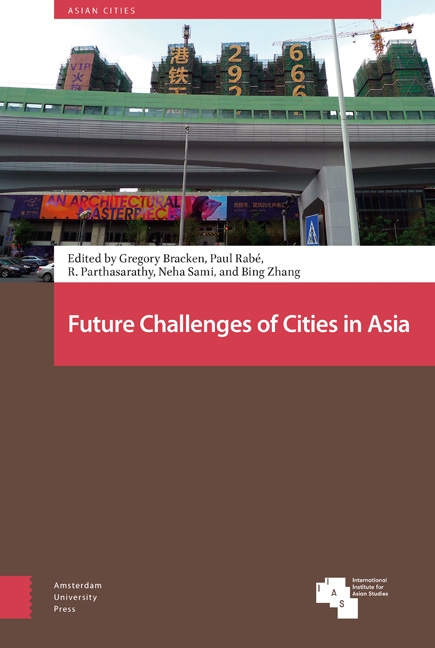Book contents
- Frontmatter
- About the Three UKNA Volumes
- Contents
- List of Figures and Tables
- 1 Future Challenges of Cities in Asia: An Introduction
- 2 Human Agency in the Asian City
- 3 Toward Inclusive, Vital and Livable City Scenarios: The Transformation of Urban Villages in Shenzhen
- 4 Cultural Dilemma in Beijing's Urban Regeneration: From Liulichang Cultural Street to Qianmen Street and Yangmeizhu Oblique Street
- 5 Housing as Heritage: The Great Urban Dilemma of the Global City of Shanghai
- 6 Not an Act of God: Lessons from a Disaster in the Settlements Planning of a River City
- 7 The Political Ecology of Climate Injustice in Bangkok
- 8 Assessing Flood-Related Vulnerability of the Urban Poor
- 9 The Ecological Future of Cities: Evaluating the Role of Green Infrastructure in Promoting Sustainability/Resilience in India
- 10 Hong Kong's “Rail-plus-Property” Development: A Model for Financing Public Transportation in Developing Cities in Southeast Asia?
- 11 Large Infrastructure Projects: The Emergence of Corridors in Asia
- Index
- Publications / Asian Cities
1 - Future Challenges of Cities in Asia: An Introduction
Published online by Cambridge University Press: 21 November 2020
- Frontmatter
- About the Three UKNA Volumes
- Contents
- List of Figures and Tables
- 1 Future Challenges of Cities in Asia: An Introduction
- 2 Human Agency in the Asian City
- 3 Toward Inclusive, Vital and Livable City Scenarios: The Transformation of Urban Villages in Shenzhen
- 4 Cultural Dilemma in Beijing's Urban Regeneration: From Liulichang Cultural Street to Qianmen Street and Yangmeizhu Oblique Street
- 5 Housing as Heritage: The Great Urban Dilemma of the Global City of Shanghai
- 6 Not an Act of God: Lessons from a Disaster in the Settlements Planning of a River City
- 7 The Political Ecology of Climate Injustice in Bangkok
- 8 Assessing Flood-Related Vulnerability of the Urban Poor
- 9 The Ecological Future of Cities: Evaluating the Role of Green Infrastructure in Promoting Sustainability/Resilience in India
- 10 Hong Kong's “Rail-plus-Property” Development: A Model for Financing Public Transportation in Developing Cities in Southeast Asia?
- 11 Large Infrastructure Projects: The Emergence of Corridors in Asia
- Index
- Publications / Asian Cities
Summary
Sometime in the next year or two, a woman will give birth in the Lagos slum of Ajegunle, a young man will flee his village in west Java for the bright lights of Jakarta, or a farmer will move his impoverished family into one of Lima’s innumerable pueblos jóvenes. The exact event is unimportant, and it will pass entirely unnoticed. Nonetheless it will constitute a watershed in human history, comparable to the Neolithic or Industrial revolutions. For the first time, the urban population of the world will outnumber the rural.
– Mike Davis, Planet of Slums (2006)In his book Planet of Slums, Mike Davis forecasts a bleak, almost apocalyptic urban future – one where there is widespread inequality and deprivation, where a majority of the urban population lives in squalor with inadequate access to basic services and with precarious employment. Although this future has not yet come to pass, there are large sections of urban populations that are increasingly vulnerable due to growing inequality, poverty, and environmental risk. However, urban regions also offer opportunities to tackle these challenges. Cities have been called “engines of economic growth,” with the ability to foster equitable development, raise the standard of living and provide economic opportunities to a wider population (Anand et al. 2014; Glaeser 2011; Sankhe et al. 2010). Cities are also extremely vulnerable to disasters and where the impacts of climate change will be felt most acutely, but they are also where some of the greatest opportunities to address these environmental challenges are emerging (Revi and Rosenzweig 2013; Revi 2009; Stone 2012).
Globally, we are at the cusp of an urban transition: 54 percent of the world's population now lives in urban centers (UN Population Division 2014). As a UN Population Division report on world urbanization prospects shows, Africa and Asia are urbanizing faster than any other part of the world: 90 percent of the urban population growth will be concentrated in these regions (ibid.). Much of this increase will take place in India and China, especially in small and emerging towns in these regions. As cities expand and push their boundaries, urban peripheries are experiencing rapid growth and development opportunities, but also the challenges that come with largely unplanned growth.
- Type
- Chapter
- Information
- Future Challenges of Cities in Asia , pp. 13 - 22Publisher: Amsterdam University PressPrint publication year: 2019



